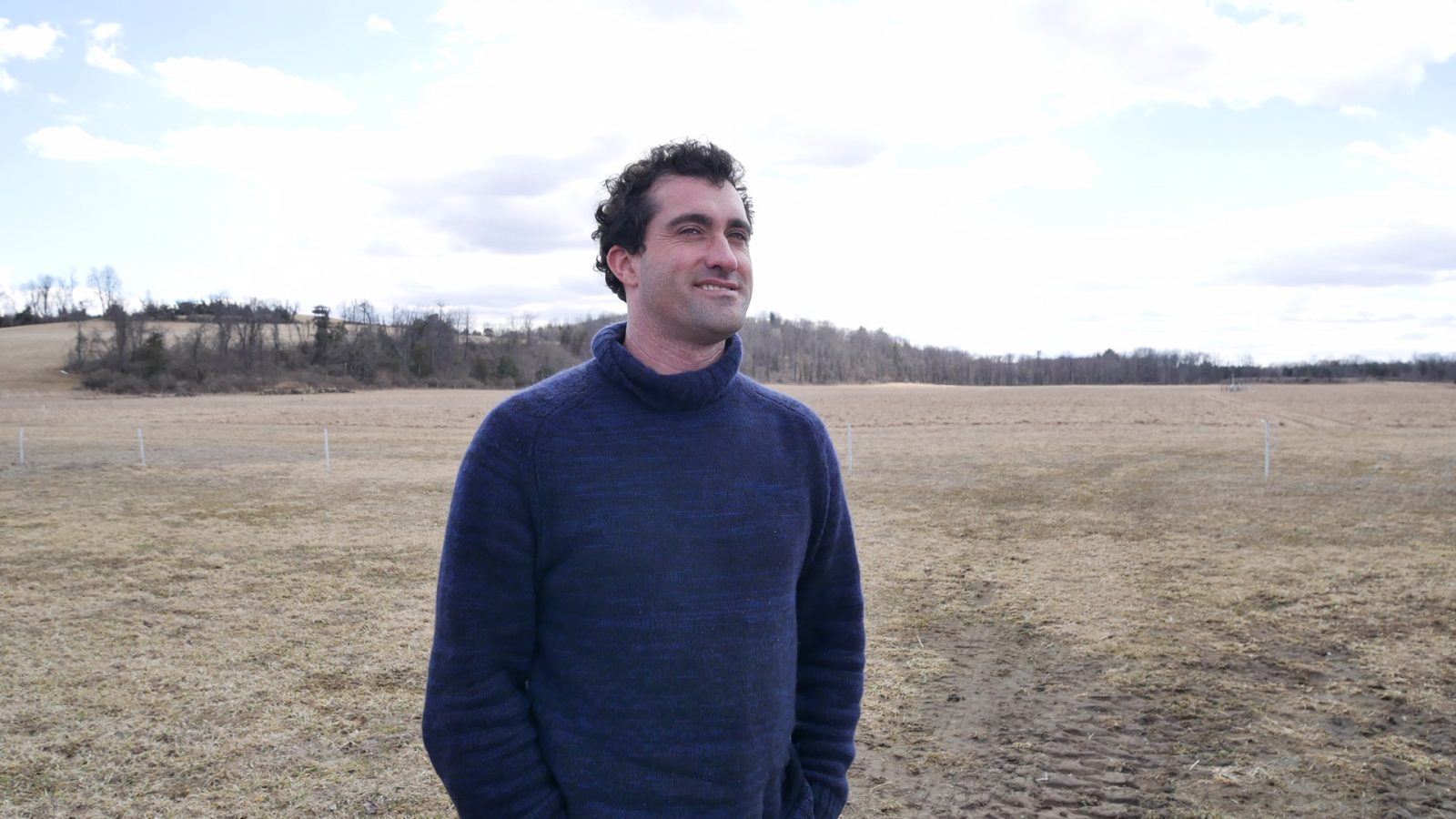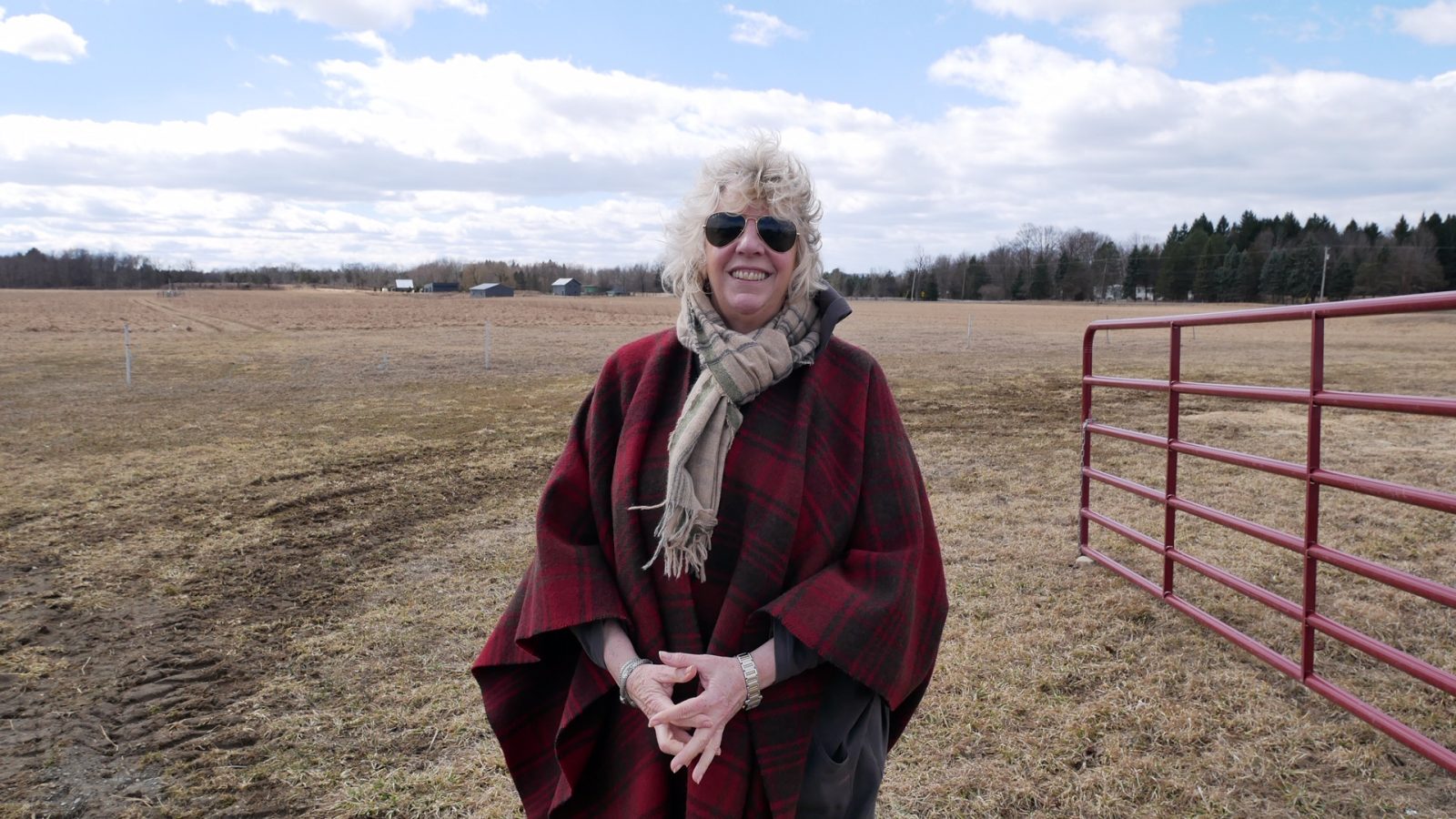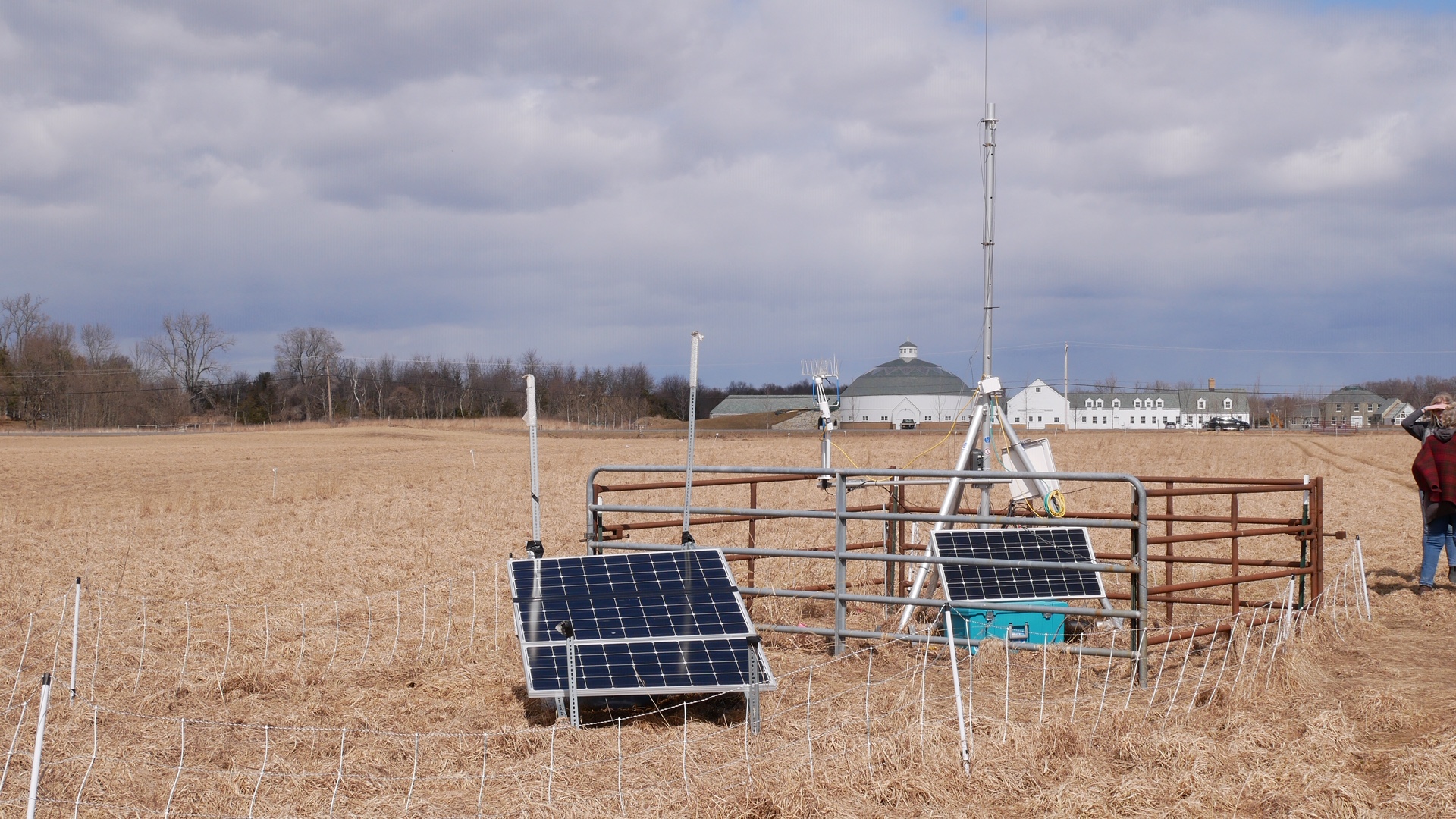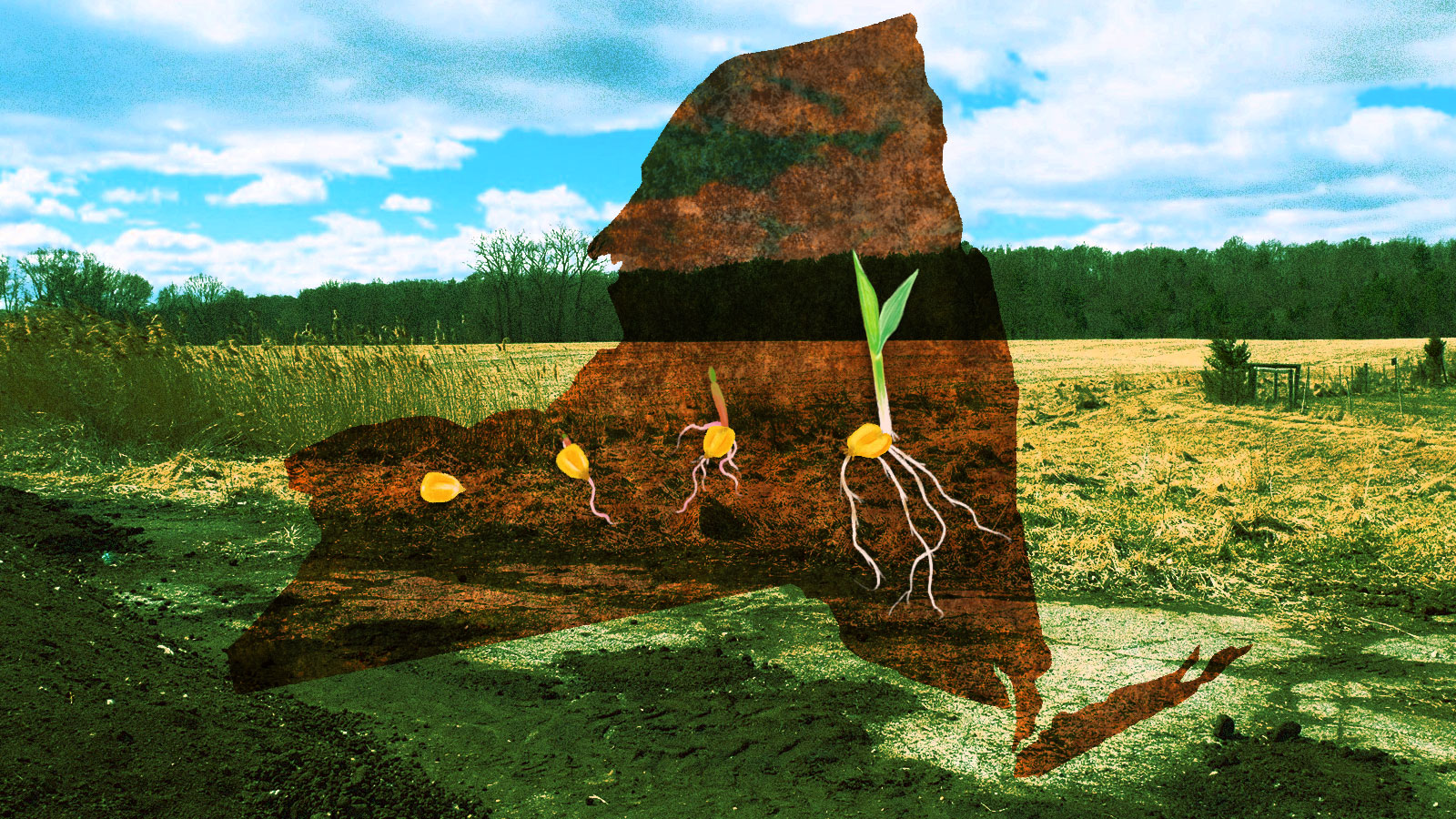Didi Barrett, a New York state assemblymember, has visited Stone House Grain, a farm in the Hudson Valley, enough times to be a seasoned tour guide. That’s what it felt like, at least, as we drove in a Jeep down a narrow road, through fields blanketed by cover crops and perennial pastures spread out like a gold-and-brown checkerboard. It was mid-March, a time of dormancy for most plants in the region. Poplar trees, bare of any leaves, lined either side of the road. But the farm was already teeming with life.
From behind the wheel, Ben Dobson, the farm manager, explained why his farm was unseasonably busy. “The basic premise of what people are now calling ‘carbon farming’ is that the earth’s surfaces were made to photosynthesize,” he said, eyeing his fields with a relaxed confidence.
It’s all part of a natural cycle: On warm days, Dobson’s crops pull carbon dioxide from the sky and release it into the soil where it nourishes developing plants. Even in the dead of winter, the fields are full of roots working to keep carbon in the soil. This is one of the ways that Dobson’s farm is able to keep carbon dioxide, the main greenhouse gas responsible for climate change, in the ground.
Dobson’s work drew the attention of Barrett a few years back. In 2015, she toured the farm for the first time and asked him for advice on how to incentivize climate change–thwarting farming practices. “It just seemed like a no brainer,” Barrett said. “New York can lead on this.” The resulting pilot project, included in this year’s state budget, will test out different methods of farming in a way that promotes soil health and fights global warming.
At one point, we stop the car to look out over rows of the dried, golden-brown remains of a soybean crop. “You see that green just creeping in?” Dobson asked.
I could just make out the flecks of green, sprouts of a rye cover crop that will grow this spring. Later, he’ll spread clover seed into that rye, he told me. When the rye dies, it will start releasing carbon dioxide, but the next crop, the clover, will be there to soak it up before it’s freed from the soil. Then, the clover will fix nitrogen — when microorganisms attach to roots, converting nitrogen into natural fertilizer for next year’s corn crop.
This constant succession of plants puts carbon to good use. Dobson calls it “building carbon momentum.” On most farms, just the opposite happens: The soil, plowed up and exposed to the air, unleashes carbon into the atmosphere. This comes with a serious toll — agriculture is responsible for 9 percent of greenhouse gases in the U.S., according to the EPA’s latest data, though some of that comes from livestock and gas-powered equipment too. The key to reversing this trend lies in taking care of the soil.
In the distance, behind the patch of soy stubble, Dobson pointed to another field filled with stalky brown plants. Those are chicory stalks, he said, a purple-flowering relative of dandelions, which will send robust roots deep into the soil to help break up the clay there, storing the carbon further down where it has a tougher time escaping into the atmosphere. Eventually, some of this carbon becomes humus, a stable form of organic matter that’s really hard to destroy.
We later drove past an area where Dobson plans on planting trees. The trees’ extensive root systems, he explained, will catch most nutrients that escape from the field before they get in the water, improving water quality. “The optimal ecological thing for this farm would be to be a huge forest,” he admitted, rather than fields of crops.
It’s true that nothing quite compares to the natural ability of trees to soak up carbon dioxide. Reforesting parts of the U.S. could sink up 307 million metric tons of carbon dioxide (equivalent to the annual emissions of more than 65 million cars), whereas cover cropping could mitigate 103 million metric tons (another 21 million cars), according to a 2018 study in Science Advances.
But humans need farms to survive. And it’s Dobson’s kind of farm that might just help us survive in the long run.
In 1977, Wendell Berry gave a prescient warning in his book The Unsettling of America: “If the present attitude continues, we may expect government policies that will encourage the destruction, by overuse, of farmland.” He foresaw that the short-sighted emphasis on production, without consideration of conservation practices like crop rotation, would only lead to a bitter end — a world without healthy soil. He wrote that “the fertility of the soil will become a limited, un-renewable resource like coal or oil.”
To some degree, Berry’s vision has come true. In the past 40 years, we’ve lost a third of all food-producing soil worldwide to erosion, according to one study. Soils, an afterthought on many conventional farms, have been depleted of life-sustaining nutrients, carbon, and microbes. This mismanaged farmland has turned many farms into a source of greenhouse gases, as opposed to a sink. Along with CO2, farms with cattle emit methane, a greenhouse gas 30 times more potent than CO2, in the form of cow farts. Nitrous oxide (aka laughing gas), a byproduct of fertilizer and another super potent greenhouse gas, also leaks into the air.
When fertilizers are applied excessively, nitrogen leaches into nearby waterways, forming toxic algae blooms, while ammonia escapes from the soil and turns into a major source of air pollution. In the end, only about half of the nitrogen farmers apply stays in the soil. To increase the fertility of their declining soil, some farmers add more nitrogen — but that’s just a Band-Aid.
While it’s not easy to restore degraded soil, that hasn’t stopped Dobson and other farmers from trying. He’s part of a worldwide “soil health revolution” with New York state at the forefront, according to a recent report by New York Soil Health. Some call the practice “carbon farming”; others know it as “regenerative agriculture.” Dobson likes to call it “real organic farming” because of his focus on building organic matter (58 percent carbon) in the soil. But the underpinning philosophy is more important to him than the name.

Ben Dobson. Grey Moran
Dobson isn’t exactly reinventing the wheel. He’s essentially mimicking what organisms have always done — removing carbon from the sky and storing it in the trees, plants, and soil. By tinkering with these natural processes, he’s able to build on what evolution has spent millennia perfecting.
“The idea is that we’re managing complex systems and letting some things, such as advanced biological systems, evolve by not disrupting them,” Dobson said. “As a farmer, my challenge is: How do I farm well within a cycle?”
So far, he’s doing pretty well. Dobson’s yields have steadily gone up, and his farm has sequestered more CO2 every year. According to his most recent data, Stone House Grain, a 2,500-acre farm, was able to sequester 403 pounds of CO2 per acre from the fall of 2016 to the fall of 2017.
Unlike conventional farmers, Dobson doesn’t till the soil very much. To preserve the carbon stored in the soil and cut down on fuel use, he employs a technique called “rolling and crimping” — where a tractor with a bladed drum attached to the front mows over the cover crop. Once the cover crop dies, it turns to mulch and then suffocates the weeds.
Another key practice is growing perennials, which have the deepest roots, and therefore the deepest stockpiles of carbon. The farm, whose chief commodity is organic grains, is now growing 55 percent perennials, including alfalfa, chicory, and hay. Rotating crops and planting an array of plant species side-by-side helps keep the soil replete with nutrients and microbes. Dobson doesn’t rotate his crops as frequently as some farmers, though. He wants to give them enough time to establish deep roots.
There was no livestock on the farm when I visited, but Dobson assured me that black and red Angus cattle will roam some of the grassy pastures later this spring, helping to enrich the soil with carbon. The methane in their dung is gobbled up by methane-eating bacteria in the soil, which break the greenhouse gas down into hydrogen and carbon. The trick, Dobson said, is making sure that the cows don’t overgraze, which could deplete the soil and release greenhouse gases stored within it. Cows are a controversial carbon-farming addition. It’s unclear whether their burps and farts of methane are offset by the carbon they help stow in the ground.
Dobson also makes his own “compost tea” — compost seeped in aerated water, which extracts the beneficial microbes and bacteria to create what is essentially kombucha for plants. This concoction, injected into the soil near the plants’ roots, helps encourage the breakdown of methane and organic matter.
He is also working to create a “closed fertility loop” on his farm, meaning that it wouldn’t rely on fertilizer, compost, or minerals from outside its boundaries. He acknowledges that he might not ever fully achieve this — it’s more of a working vision. The soil in his area is particularly depleted of calcium, so he imports limestone to remineralize the soil. He also relies on chicken manure from a nearby chicken farm to add nitrogen, phosphorous, and potassium. Every year, as the soil gets healthier, he uses less chicken manure and gets a little bit closer to closing the loop.
As Dobson adds more trees and expands the amount of pasture, the farm might start to look less like the farms we know — neat, flat squares of yellow and green — and come to look a little more dynamic and wild.
Dobson was lucky, in a sense. He was hired by the owners of Stone House Grain with the purpose of helping transition the operation to a carbon-sequestering, organic farm. But not all farmers are in the same position, and transitioning old systems and equipment requires time and money. Part of the issue is there aren’t enough policies to support the transition process. There’s where Barrett’s legislation comes in — to help support more Ben Dobsons.
Many agricultural policies are designed to help traditional industrial farms, despite that some of their practices harm the environment. For instance, many farms significantly contribute to water pollution but receive exemptions under the Clean Water Act. Peter Lehner, a lawyer at Earthjustice, points out that in New York state, landowners are eligible to receive a tax reduction based solely on the size of their operation and income, without meeting any environmental requirements. When farmers suffer from crop losses from an erratic climate, the Federal Crop Insurance Program will often bail them out. In other words, few policies encourage farmers to move in a different direction.
What makes Barrett’s policy particularly groundbreaking is that she wants to incentivize sustainable farming and climate-friendly practices instead. The pilot program, included in this year’s state budget, will involve experimenting with different carbon sequestering techniques on farms in Dutchess County, less than 100 miles north of New York City, to see if the practices could feasibly scale up to the rest of the state.
Already, research is underway to figure out how to incentivize these methods. In 2017, Barrett’s $50,000 study examining financial mechanisms to support carbon farming, such as tax credits, was included in the state budget. The study is expected to conclude this year.
Barrett described her program as a “carrot, rather than the stick, approach.” Most climate legislation, she pointed out, is about disincentivizing what is bad. “You hear over and over again about carbon taxes and carbon penalties,” Barrett said. Her policy would incentivize the positive: the often overlooked saving graces of dirt.
And dirt could save us big time. If farmers across the world turned their farms into carbon sinks, global greenhouse gas emissions could be cut by 15 percent, according to a study in Science. The Marin Carbon Project in California, one of the early adopters of carbon farming in the U.S., has been able to reduce 1.5 million metric tons of greenhouse gases in three years across 65,000 hectares, according to one study. If carbon farming was adopted in 5 percent of California’s rangelands, the authors estimate that it could offset one year’s worth of emissions from the state’s agriculture and forestry industries.

Didi Barrett. Grey Moran
Barrett’s pilot program has tough questions to tackle — like how to measure soil health, for instance. There’s not an agreed-upon definition of what makes soil healthy, which makes this process, well, tricky. “While the amount of carbon in the soil, especially in the form of organic matter, is one good indicator of soil health, just measuring carbon is too narrow,” said Elizabeth Henderson, a New York state farmer, writer, and activist.
Dobson acknowledged that there’s a potential limitation in the pilot program in its current form: So far, it’s only looking at practices to maximize carbon dioxide sequestration in the soil, without accounting for other greenhouse gases. It’s possible that farmers could game the system, piling fertilizer and manure onto the farm to increase the amount of carbon, inadvertently leading to a spike in nitrous oxide and methane. Ideally, Dobson said, a climate-friendly farming policy would consider greenhouse gases beyond carbon dioxide, helping to thwart climate change and support a new approach to agriculture at the same time.
“It’s our intention to look at other greenhouse gases,” Barrett said. She emphasized that the pilot program is still a work in progress, and it will be working closely with farmers throughout the process of figuring out what to measure.
New York state has a methane reduction plan, which aims to slash emissions in every sector including agriculture, and offers grants to support soil health and climate resiliency projects on farms. Yet there is not a robust policy to offer the financial support necessary to encourage the widespread uptake of these practices. If Barrett’s pilot program is able to do so, it would help support a new approach to agriculture, offering a model for the rest of the country.
Besides mitigating climate change, there are other reasons — more selfish ones — that farmers might want to adopt the sort of practices Dobson employs and Barrett is pushing. Healthy soil comes with a suite of ecological services: It reduces erosion and water retention, and also makes for healthier farms overall, helping them “build resilience to extreme weather events,” according to Cornell’s New York State Soil Initiative.
And with climate change, those events are happening more and more. There’s a lot at stake for farmers, who depend on stable weather patterns. Last fall, New York was hit with its hardest rainfall in years. Between August and September, it rained 44 percent of the days in the Hudson Valley. Dobson noticed that his neighbors with degraded soils were suffering. “A lot of conventional farms had their hardest harvest season in decades because of how wet it was,” he said. Many farmers “simply couldn’t get on their fields,” which were pooled with water. Their yields went down as a result, Dobson said.
Dobson’s healthier soil, which is richer in carbon and microbes, is more sponge-like. It can more easily release water when it’s dry and hold onto it when it’s too wet. As a result, his crops have thrived, even in a more erratic climate. “You know, we’ve seen massive amounts of rainfall and more prolonged periods of drought recently,” Dobson said. Yet his operations haven’t suffered too much: He’s barely seen any erosion or soil loss, and only a small drop in crop yield. And after a big rain, he’s able to get back to working in the fields more quickly than his neighbors.
Other New York carbon farmers have noticed that their farms are better able to withstand drought and flooding. Donn Branton, a farmer in the western New York town of Le Roy, between Buffalo and Rochester, said that his farm produces fruitful yields even during unfavorable weather conditions. One of the most visible indicators of drought, he said, is the way his “corn rolls up like cigar rolls.” Compared to other farmers in his area, he said, his corn remains uncurled for longer.
Klaas Martens, a farmer in Penn Yan who has been carbon farming for 20 years, has observed similar results. In 2016, New York state experienced one of its worst droughts in decades. Martens recalled that in parts of his neighbors’ farms there were no crop yields at all. Yet for him, it was a “banner year,” one of the best harvests he’s had.

Grey Moran
Back at Stone House Grain, on the last stop of our tour, we arrived at a field with a contraption that looks decidedly out of place on the farm. Barrett, Dobson, and I all huddled around a tower constructed out of white poles with a thin rod extending from the top. A solar panel, positioned on the ground, powered the device.
“This unit right here is taking a reading of the atmospheric carbon dioxide every 30 seconds,” Dobson explained. “It’s calibrated to read the CO2 going in and out of the land, up to a hundred meters” — as big as the field around us. The machine is able to detect fluorescent radiation, which is emitted by plants when they photosynthesize. Dobson also uses portable devices to measure methane and nitrous oxide.
To experiment with ways of measuring soil health, Dobson started a nonprofit, Hudson Carbon, in partnership with the Woods Hole Oceanographic Laboratory. Contraptions like the one at Stone House Grain could be used to benchmark various carbon farming practices against one another.
Dobson’s work is an early step toward finding a way to grow food that restores, rather than exhausts, the earth. “We’re not all the way there yet,” he said. “Humanity has yet to discover 98 percent of what’s under our feet.”



